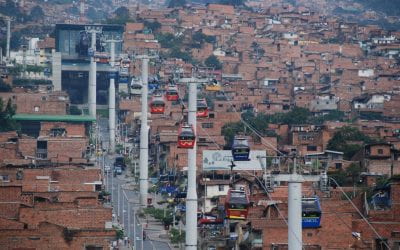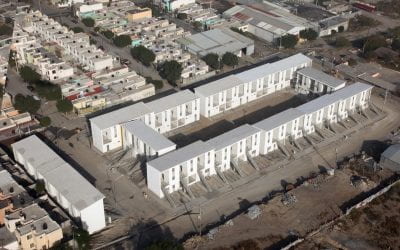A Review of Poverty and Poverty Alleviation Strategies in North America
Social Policy and Anti-Poverty Strategies: Comparative Viewpoints
The eight essays in this volume, coedited by Mary Jo Bane, Thornton Bradshaw Professor of Public Policy and Management at the Harvard Kennedy School, and René Zenteno, Professor at the Graduate School of Public Administration and Public Policy at the Tecnológico de Monterrey, represent an important contribution to our knowledge of the social policies and anti-poverty strategies undertaken in North America. The co-edited volume is a collection of essays that were first presented at the conference Poverty and Poverty Reduction Strategies: Mexican and International Experience that took place in Monterrey, Mexico, in January 2005.
More than in the importance of the single contributions, the value of the volume lies in the successful attempt of providing an insightful analysis of social policies and specific poverty alleviation strategies by studying their development and outcomes in the United States and Mexico.
The book successfully combines the analysis of growth-enhancing policies, as well as human capital and specific social protection policies and how their interrelationship can effectively reduce poverty. Lessons and policy implications are drawn for Mexico, the poorest and more unequal among the North American countries examined. The comparative approach is also valuable as it provides the background to understand the current situation and the controversy around some of the policies. The book should be in the required reading list of any course on public policy, poverty and inequality.
The volume is divided into four parts. The opening part provides the context and background of the book, offering a comprehensive overview of the evolution of poverty in North America, as defined by different national and international sources, and how it varies along different dimensions, including geography, race/ethnicity and household composition in the United States, Mexico and with a more limited focus in Canada. Mexico appears to be the country where hard core poverty is more geographically concentrated, and also where market exposure and social modernization have not prevented extreme poverty from being related to indigenous status. The chapter underlines the importance of examining not only trends in growth but also in income distribution and how different concepts and approaches can be better suited to examine different aspects of poverty across countries.
The second section highlights the importance of development to fight poverty in Mexico, focusing on the channels through which growth affects the income of the poor, as well as on complementary institutional polices as a way of ensuring lasting poverty reduction, and finally on the adjustment to economic change of the low-income population.
Gonzalo Hernández and Miguel Székely examine how growth, economic stability and increased public spending have had an effect on poverty reduction in the last half-century in Mexico. What emerges from their decomposition breakdown of GDP growth into the elements that may have an effect on poverty reduction demonstrates that improvements in labor productivity may play a critical role in fostering development and being an overall effective anti-poverty strategy. Specifically, they show how a combination of macroeconomic policies and social reforms can improve income at the low-end of the distribution.
Michael Walton’s essay moves to the next level, by examining the policy mechanisms that can make macro policies effective in improving income distribution. That is, the author focuses on the distributional consequences of how institutions define “the rules of the game” (North 1990). Drawing on international experience, the main contribution of the paper is to highlight that the heterogeneity in outcomes of policies such as trade liberalization, financial liberalization, privatization, and in particular in outcomes related to poverty reduction, arises from the fact that the distributional consequences of growth policies are highly dependent on the existing distribution of power and the system of incentives that shape institutions. Therefore, the effectiveness of market-related policies on poverty reduction needs to be guaranteed with complementary policies that introduce some kind of social accountability and external mechanisms of control.
The focus of the third essay of the second section is on the dynamics of the ability of the poor to cope with economic change. Mercedes González de la Rocha documents how changing labor market conditions in the 1990s and 2000s have increased risks and insecurity faced by the poor also by affecting their resourcefulness and their responses at the household level. That is, the increased insecurity concerning labor income, which represents the main source of income for the poor, has generated cumulative disadvantages by destabilizing the household’s social organization and weakening social networks, with the overall effect of undermining their capability of coping with spreading risk and ultimately leading to social isolation.
The focus of the third section shifts to education policy, which is regarded as an anti-poverty strategy, since the distribution of educational opportunities is highly correlated with income inequality, as well as long-run term growth and development strategy. And again, in the 21st century global competition for the world’s most valuable asset, human capital, Mexico lags behind its OECD counterparts.
In this regard, in a recent joint paper with my colleague Lant Pritchett, we confirm the lagging performance of Mexico in internationally comparable examinations. We also show how low average quality in international comparisons implies for Mexico that very few students are at global high quality and that by sorting students on household socio-economic status, not ability, Mexico is recruiting from a narrow base and producing a very small number of very highly skilled workers (Pritchett L. and M. Viarengo, 2009, “Producing Superstars for the Economic Mundial: The Mexican Predicament with Quality of Education,” chapter 2 in the “Mexico Competitiveness Report 2009” of the World Economic Forum, Ricardo Hausmann, Emilio Lozoya Austin and Irene Mia (eds.).
The chapter by Carlos Muñoz-Izquierdo and Guadalupe Villarreal-Guevara describes compensatory education programs and carefully examines the Oportunidades Program, first started under the name Progresa in 1997, with the aim of providing low-income families with subsidies to encourage them to keep children in school. According to the authors, who provide an evaluation and also rely on the existing literature, it is difficult to separate the effect of the compensatory programs from the impact of the school input policies. However, the Oportunidades Program has had a positive effect on enrollments and attendance but so far it is not possible to see significant improvements in educational achievement, making the Program unsuccessful in attempting to improve the educational achievement gap.
In this regard, Richard Elmore reminds us of the importance of adopting comprehensive policies that take into account differences in the existing learning environments and the different incentives of agents who operate in the education system. Drawing on two U.S. case studies, on Extend and Stable, Elmore emphasizes the importance of considering the process of school improvement at the level of practice, mainly in three domains: the technical organization, as well as the policy and politics domains.
In the first of the two chapters devoted to the issue, Agustín Escobar Latapí focuses on the social-assistance side of the Oportunidades Program and on how it could further develop to become a social assistance program. The program design proposed relies on an extension of the eligibility for households that experience unanticipated income losses and for the elderly: the introduction of incentive schemes to maximize the efficient use of the resources provided and minimize the dependence on them; as well as a complementary program of assistance and coordination between the agencies.
The origins and subsequent developments of President Lyndon Johnson’s 1964 War on Poverty are examined in the last chapter by Sheldon and Sandra K. Danzinger. The authors examine the evolution of income-tested cash assistance programs by focusing on programs for families with children. They provide a very clear and effective analysis on how the focus of welfare reform targeted to the poor has shifted over time from increasing income of the non-working poor to providing resources for the low-income working parents.
The U.S. experience is then compared to other industrialized countries and reveals that the United States provides less support to the poor also as a result of the preference for “equal opportunity, not equal outcome” and the underlying system of reciprocal altruism which is different from the one existing in most European countries (Alesina et al. 2001).
Policy implications are drawn for Mexico and the possibility of introducing a non-contributory income-tested cash transfer for the elderly is considered to be feasible for the Mexican economy in order to develop a more comprehensive anti-poverty strategy.
In the conclusion to the volume, Mary Jo Bane and René Zenteno stress not only the importance of development for Mexico as the first strategy in the fight against poverty but they also recognize the essential role played by governance, the need for coordinating policies, and some of the possible consequences of migration and development, and of course the importance of focusing on other domains relevant to poverty alleviation.
Yet there is much more to be done, particularly in the areas of health, training programs and social infrastructure. The renewed sense of urgency for faster and deeper poverty reduction has led to a growing discourse on the determinants of poverty and the strategies for poverty alleviation in North America, and Mary Jo Bane and René Zenteno have paved the way to move the policy debate forward.
Spring | Summer 2010, Volume IX, Number 2
Martina G. Viarengo is an Economist at the London School of Economics and a Postdoctoral Fellow at Harvard University’s John F. Kennedy School of Government. For the past several years, Viarengo has been examining education policy and labor market outcomes in the OECD and developing countries, devoting her academic research to understanding how to improve access to quality education to reduce poverty and inequality.
Related Articles
Architecture: Editor’s Letter
For years, readers have been commenting on the printed edition of ReVista: “How beautiful!” Now here’s a website to match, thanks to the efforts of the design firm 2communiqué and Kit Barron of DRCLAS. It’s not only a question of reflecting the aesthetics of the printed…
Working in the Antipodes
I was asked by ReVista to write an article on my own work, specifically about the fact that I do simultaneous work on social housing and high-profile architectural projects, something that is, to…
Three Tall Buildings
I used to hate the three tall towers that thrust against the verdant mountains. I used to think that the red brick towers dug into the landscape, belonging to some other city and some other space, created a scar of modernity…





